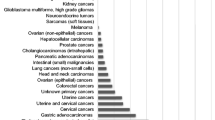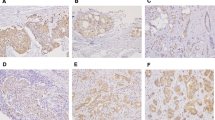Abstract
Mammary phyllodes tumors are uncommon stromal-epithelial neoplasms, and are divided into benign, borderline malignant and frankly malignant groups on the basis of their histological features. Accumulating evidence shows that epidermal growth factor receptor (EGFR) is involved in the pathogenesis and progression of many malignancies. This study investigated 453 phyllodes tumors (296 benign, 98 borderline, 59 malignant) for EGFR expression using immunohistochemistry (IHC) and fluorescence in situ hybridization (FISH) for gene amplification. The staining was correlated to tumor margin status, degree of malignancy, stromal cellularity, mitotic activity, nuclear pleomorphism and stromal overgrowth. Cases with strong positive IHC staining were selected for FISH. The overall positive rate for EGFR was 16.2% (48/296), 30.6% (30/98) and 56% (33/59) for benign, borderline malignant and frankly malignant phyllodes tumors, respectively. FISH demonstrated egfr gene amplification in 8% of immunohistochemically positive cases. The results of this study provide strong evidence that EGFR overexpression is involved in the pathogenesis of phyllodes tumors, although gene amplification may not be the major underlying mechanism for overexpression.




Similar content being viewed by others
References
Reinfuss M, Mituś J, Duda K et al (1996) The treatment and prognosis of patients with phyllodes tumor of the breast: an analysis of 170 cases. Cancer 77:910–916
Pietruszka M, Banes L (1978) Cystosarcoma phyllodes: a clinicopathological analysis of 42 cases. Cancer 41:1974–1983
Salvadori B, Cusumano F, Del Bo R et al (1989) Surgical treatment of phyllodes tumors of the breast. Cancer 63:2532–2536
Halverson JD, Hori-Rubaina JM (1974) Cystosarcoma phyllodes of the breast. Am Surg 40:295–301
Kersting C, Kuijper A, Schmidt H et al (2006) Amplifications of the epidermal growth factor receptor gene (egfr) are common in phyllodes tumors of the breast and are associated with tumor progression. Lab Invest 86:54–61
Tan PH, Jayabaskar T, Yip G et al (2005) p53 and c-kit (CD117) protein expression as prognostic indicators in breast phyllodes tumors a tissue microarray study. Mod Pathol 18:1527–1534
Niezabitowski A, Lackowska B, Rys J (2001) Prognostic evaluation of proliferative activity and DNA content in the phyllodes tumor of the breast: immunohistochemical and flow cytometric study of 118 cases. Breast Cancer Res Treat 65:77–85
Tse GM, Lui PC, Lee CS et al (2004) Stromal expression of vascular endothelial growth factor correlates with tumor grade and microvessel density in mammary phyllodes tumors: a multicenter study of 185 cases. Hum Pathol 35:1053–1057
Tsai WC, Jin JS, Yu JC et al (2006) CD10, actin, and vimentin expression in breast phyllodes tumors correlates with tumor grades of the WHO grading system. Int J Surg Pathol 14:127–131
Tse GM, Putti TC, Kung FY et al (2002) Increased p53 protein expression in malignant mammary phyllodes tumors. Mod Pathol 15:734–740
Perry A, Kunz SN, Fuller CE et al (2002) Differential NF1, p16, and EGFR patterns by interphase cytogenetics (FISH) in malignant peripheral nerve sheath tumor (MPNST) and morphologically similar spindle cell neoplasms. J Neuropathol Exp Neurol 61:702–709
Tan PH, Jayabaskar T, Chuah KL et al (2005) Phyllodes tumors of the breast: the role of pathologic parameters. Am J Clin Pathol 123:529–540
Bencardino K, Manzoni M, Delfanti S et al (2007) Epidermal growth factor receptor tyrosine kinase inhibitors for the treatment of non-small-cell lung cancer: results and open issues. Intern Emerg Med 2(1):3–12
Le Tourneau C, Faivre C, Siu LL (2007) Molecular targeted therapy of head and neck cancer: review and clinical development challenges. Eur J Cancer 43(17):2457–2466
Feakins RM, Wells CA, Young KA (2000) Platelet-derived growth factor expression in phyllodes tumors and fibroadenomas of the breast. Hum Pathol 31:1214–1222
Chan YJ, Chen BF, Chang CL et al (2004) Expression of p53 protein and Ki-67 antigen in phyllodes tumor of the breast. J Chin Med Assoc 67:3–8
Chen CM, Chen CJ, Chang CL et al (2000) CD34, CD117, and actin expression in phyllodes tumor of the breast. J Surg Res 94:84–91
Tse GM, Putti TC, Lui PC et al (2004) Increased c-kit (CD117) expression in malignant mammary phyllodes tumors. Mod Pathol 17:827–831
Lynch TJ, Bell DW, Sordella R et al (2004) Activating mutations in the epidermal growth factor receptor underlying responsiveness of non-small-cell lung cancer to gefitnib. N Engl J Med 21:2129–2139
Ji H, Zhao X, Yuza Y et al (2006) Epidermal growth factor receptor variant III mutations in lung tumorigenesis and sensitivity to tyrosine kinase inhibitors. Proc Natl Acad Sci USA 103:7817–7822
Lee J, Vivanco I, Beroukhim R et al (2006) Epidermal growth factor receptor activation in glioblastoma through novel missense mutations in the extracellular domain. PLoS Med 3(12):e485
Sugawa N, Ekstrand AJ, James CD et al (1990) Identical splicing of aberrant epidermal growth factor receptor transcripts from amplified rearranged genes in human glioblastomas. Proc Natl Acad Sci USA 87:8602–8606
Steinman S, Wang J, Bourne P et al (2007) Expression of cytokeratin markers, ER-alpha, PR, HER-2/neu, and EGFR in pure ductal carcinoma in situ (DCIS) and DCIS with co-existing invasive ductal carcinoma (IDC) of the breast. Ann Clin Lab Sci 37:127–134
Yang JL, Hannan MT, Russell PJ et al (2006) Expression of HER1/EGFR protein in human soft tissue sarcomas. Eur J Surg Oncol 32:466–468
Reis-Filho JS, Pinheiro C, Lambros MB et al (2006) EGFR amplification and lack of activating mutations in metaplastic breast carcinomas. J Pathol 209:445–453
Sato O, Wada T, Kawai A et al (2005) Expression of epidermal growth factor receptor, ERBB2 and KIT in adult soft tissue sarcomas: a clinicopathologic study of 281 cases. Cancer 103:1881–1890
Suo Z, Nesland JM (2000) Phyllodes tumor of the breast: EGFR family expression and relation to clinicopathlogical features. Ultrastruct Pathol 24:371–381
Wang X, Jones TD, Zhang S et al (2007) Amplifications of EGFR gene and protein expression of EGFR, Her-2/neu, c-kit, and androgen receptor in phyllodes tumor of the prostate. Mod Pathol 20:175–182
Kersting C, Tidow N, Schmidt H et al (2004) Gene dosage PCR and fluorescence in situ hybridization reveal low frequency of egfr amplifications despite protein overexpression in invasive breast carcinoma. Lab Invest 84:582–587
Kersting C, Packeisen J, Leidinger B et al (2006) Pitfalls in immunohistochemical assessment of EGFR expression in soft tissue sarcomas. J Clin Pathol 59:585–590
Agelopoulos K, Kersting C, Korsching E et al (2007) Egfr amplification specific gene expression in phyllodes tumors of the breast. Cell Oncol 29(6):443–451
Dobashi Y, Suzuki S, Sugawara H et al (2007) Involvement of epidermal growth factor receptor and downstream molecules in bone and soft tissue tumors. Hum Pathol 38:914–925
Wong SF (2005) Cetuximab: an epidermal growth factor receptor monoclonal antibody for the treatment of colorectal cancer. Clin Ther 27:684–694
Feng FY, Lopez CA, Normolle DP et al (2007) Effect of epidermal growth factor receptor inhibitor class in the treatment of head and neck cancer with concurrent radiochemotherapy in vivo. Clin Cancer Res 13:2512–2518
Perez-Torres M, Guix M, Gonzalez A et al (2006) Epidermal growth factor receptor (EGFR) antibody down-regulates mutant receptors and inhibits tumors expressing EGFR mutations. J Biol Chem 281:40183–40192
Paez JG, Jänne PA, Lee JC et al (2004) EGFR mutations in lung cancer: correlation with clinical response to gefitinib therapy. Science 304:1497–1500
Smith J (2005) Erlotinib: small-molecule targeted therapy in the treatment of non-small-cell lung cancer. Clin Ther 27:1513–1534
Author information
Authors and Affiliations
Corresponding author
Rights and permissions
About this article
Cite this article
Tse, G.M.K., Lui, P.C.W., Vong, J.S.L. et al. Increased epidermal growth factor receptor (EGFR) expression in malignant mammary phyllodes tumors. Breast Cancer Res Treat 114, 441–448 (2009). https://doi.org/10.1007/s10549-008-0030-5
Received:
Accepted:
Published:
Issue Date:
DOI: https://doi.org/10.1007/s10549-008-0030-5




